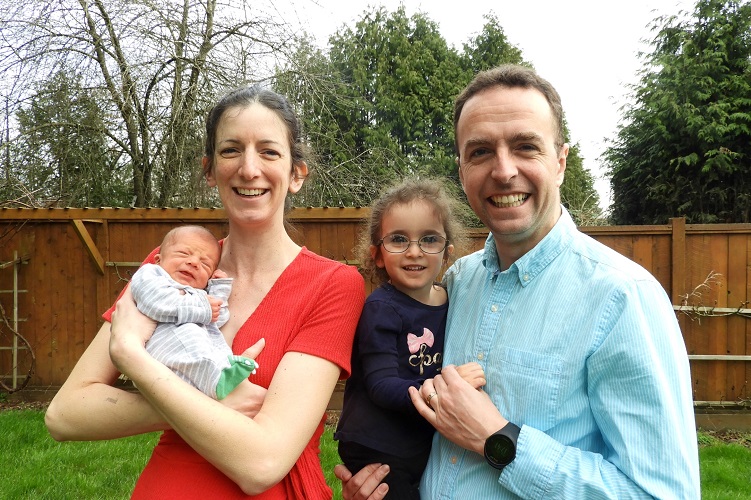Our son Steffan was born this month weighing 5lb 9oz. Mum did fantastically well and Steffan seems to be a healthy baby. Here are some pics of Steffan:









In early May I decided to learn more about one of the popular infographic tools available on the web because infographics can deliver complex information simply and concisely. This makes them useful for communications professionals delivering key messages in environments where competing demands on audience attention limit the time available to digest information.
Infogr.am was a fairly simple tool to use and it delivers bright, clear graphics. I used the free tool which provides a useful suite of basic options, but more functionality can be unlocked through its subscription service.
I based my infographic on the performance of Barclays Premier League (BPL) goal scorers because, in my spare time, I like to play Fantasy Premier League (FPL). I am particularly drawn to the statistical analysis side of the game and I like diving into the data to get a better understanding of the past, present and potential future returns a player is likely to generate for a team.
The viewer can see at a glance:
An audience of experienced FPL players can use that information to adjust their player picks to deliver greater returns.
Congratulations to the USA on winning a wonderful Women’s World Cup. I’ve seen six games and some outstanding play in the 2015 tournament, including a couple of cracking goals in the final. To have been in Vancouver’s stadium with more than 53,000 other spectators on three occasions – less than 25 years after my sister had to campaign to be allowed to play football at school – was a great experience.

The USA celebrates winning the Women’s World Cup 2015
There is a line in Terminator Genisys in which Arnold Schwarzenegger’s Terminator says he is “old, but not obsolete”. This is the most memorable line from the movie, not because you are working through the concept of a T-800 aging (though you are), but because it pretty much sums up the state of the Terminator franchise.
To recap, the original tapped the early 1980s zeitgeist concern about robots replacing people to create a taut, atmospheric horror movie. The sequel expertly blended a solid character-driven story with pioneering computer effects – which still matches those on screen 24 years later – to deliver an action movie so polished it shines like a liquid T-1000. The next two movies were a shadow of the first two, but with the fifth the franchise is really beginning to feel old.
Genisys opens by literally retracing the Terminator’s steps to try to recapture the early franchise magic, but ends by wheezing through looking ready for retirement. A poorly explained timeline twist reunites warrior-from-the-future Kyle Reese (Jai Courtney) with a reprogrammed T-800 à la Terminator 2 and a Sarah Connor (Emilia Clarke) that splices 1984 and 1991 versions of the character.
I am a fan of strong female characters in movies and they don’t come much tougher than the 1991 Sarah Connor. Linda Hamilton superbly played a waitress turned mother teaching her son to become a “great military leader”. She was so tough she looked like she was carved from pink granite. Emilia Clarke may be khaleesi in Game of Thrones but in Genisys she comes across as the waitress pretending to be the tough Sarah Connor. And when she calls the T-800 “Pops” all pretense is lost and the movie begins to slip away.
We proceed through the usual shootouts and chase scenes expected of a Terminator movie, but they feel run-of-the-mill, lacking the terror of the original or the heft of the second. Genisys becomes infected with the modern Hollywood disease of replacing story, drama and tension with crash, bang and pixel wallop. Ironically, given the central premise of the Terminator movies, I came away feeling that if more energy had been directed away from the computers and into human storytelling, this franchise could have a future.
Terminator Genisys feels old, but I won’t write the concept off as obsolete just yet.

O Captain! My Captain! The classic scene from Robin Williams’ 1989 film Dead Poets Society
When Harold Ramis died earlier this year, an old friend of mine complained that his social network feed was filled with comments about the writer, actor and director. While I can understand where my friend is coming from in terms of public outpourings of grief for people we do not personally know, the fact remains that Ramis and others can touch our lives through the movies they make, the stories they tell.
Stories have been at the heart of human civilization for as long as there has been civilization. Whether it is in cave paintings or in oral history passed from elder to younger, the ballads of wandering minstrels or the celluloid works of Hollywood, stories are told. Sometimes the stories drip off us, having as much impact as rain on granite. At other times they can act more like storm waves on the coast, potentially altering the very landscape of the viewer, reader or listener.
So when a storyteller passes on, their departure may kindle sadness in those who have been touched by the stories they told. For sure, our sadness is unlikely to match the levels of grief experienced by the family and friends of the departed, but we can lament the passing of someone who told stories that had resonance in our own lives.
With that in mind, I make no apologies for my first thought being “O Captain! My Captain!” upon hearing that actor and comedian Robin Williams had died. The line is the title of a Walt Whitman poem made famous to a new audience in the 1989 Oscar-winning movie Dead Poets Society, in which Williams starred.
In Britain in the late 1980s, we had to wait at least four years for a movie to appear on one of the four terrestrial television channels if we missed a film in the cinema and had no video player. Therefore I was a teenager coming of age, like the boys at the heart of Dead Poets Society, when I first saw that film. The main themes of the movie – seize the day, suck the marrow out of life – resonated with me. Regardless of whether they were over-egged, as some critics have argued, when they hit you as a teenager you don’t have the same weary years of experience as those critics.
“Sucking the marrow out of life doesn’t mean choking on the bone” – Keating
While Tom Schulman deservedly received an Oscar for the script, Williams and his fellow actors are the medium through which those themes were delivered. They imbued them with life and infused them with soul. Williams turned in a fine performance as teacher and ‘Captain’ John Keating, ensuring that you did not leave the film sensing rotting eggs but the nourishing ground of more thoughtful nuance.
Another 1980s Robin Williams film I did not see until the 1990s was Good Morning, Vietnam. Williams, as disc jockey Adrian Cronauer, ad-libs at the microphone, belting out some cracking lines in one of his very best comedic performances. The movie came out in 1987 in the middle of America’s great introspection on Vietnam – the same year as Full Metal Jacket, a year after Platoon and two years before Born on the Fourth of July. Williams’ zany brand of comedy is at the centre of Good Morning, Vietnam, but that does not stop it tackling the more obvious emotions of war in a way that can have an impact like those other films.
In both Dead Poets Society and Good Morning, Vietnam the world is not black or white, marrow or bone, laughter or sorrow, but something more complex. With Williams at their core, the films are no shade of grey either. They are a complex tableau of colour, much like Williams himself.
Life is also a tableau of colour. If someone adds another shade or a splash to the canvas through the stories they tell, it should not be a surprise if we choose to embrace a little re-telling when they depart.
On this day 69 years ago more than 150,000 Allied service personnel began landing in north west Europe. D-Day was one of the key actions of World War Two. It established a beachhead that allowed men and equipment from the UK, US, Canada and other allied nations to mount the offensive that would, with a Russian push from the east, liberate Europe from Nazi control.
One of my favourite and most memorable interviews was with Harry Wheeler, who was a sapper in 249 Field Squadron of the Royal Engineers in 1944. I am deeply honoured to have been the first journalist to tell the story of how this absolute gentleman was one of the very first Allied soldiers to land on European soil shortly after midnight on June 6, a few hours ahead of the ship-borne forces.
Sapper Wheeler and his comrades secured a crucial canal bridge that today is known as Pegasus Bridge. Had they not succeeded, Field Marshal Erwin Rommel would have been able to bring divisions from the east to halt the allied invasion as troops came off the beaches. Many would call Harry Wheeler a hero, but he told me:
“I’m not a hero. I was a scared young man. Those are the heroes, lying dead in France.”
They all played their part in saving Europe from Nazi tyranny. And the generations that follow should take a moment to say thank you to them and all those who served with them in World War Two.
At the going down of the sun and in the morning, we will remember them.

Harry Wheeler’s D-Day story, as told to David Connop Price for the Henley Standard, March 10th, 2006
Notes:
City of Glass has become a nickname for Vancouver – one given prominence thanks to Douglas Coupland’s book of the same name.

In the City of Glass it is often possible to see more buildings than those physically in front of you
© David Connop Price
The famous author’s observation about the city he lives in is borne out by an amble downtown. I took just such a leisurely stroll on a sunny afternoon this past weekend and my camera was drawn to the play of light and reflection off the glass.

One building mirrors another in downtown Vancouver
© David Connop Price

The forest of glass tower blocks does allow some sunlight to filter through
© David Connop Price

Vancouver Convention Centre makes a grand canvas on which to view an early evening sky
© David Connop Price
Since I moved to British Columbia last year I have been told many times that the NDP were going to win the 2013 provincial election. Tonight they lost – comprehensively. Almost everyone except the most optimistic Liberal was surprised. But those predicting an NDP win were backed up by polls predicting they should win comfortably. With support at 48 per cent, the NDP entered the campaign 19 per cent clear of their Liberal rivals according to an Ipsos-Reid poll.
During the campaign the polls clearly tightened. By the start of May the Liberals had chopped that lead in half, a new Ipsos Reid poll showed. They were polling at 35 per cent (up six per cent) while the NDP was at 45 per cent (down three per cent), as the Liberals at this stage appeared to benefit from the drop away in support for the BC Conservatives (down three per cent to seven per cent).
The day before polling day, Ipsos-Reid found a further tightening of race, with the NDP on 45 per cent (no change) and the Liberals up two per cent to 37 per cent. This is not to pick on Ipsos-Reid. An Angus-Reid poll conducted in the two days before election day was remarkably similar, putting the NDP on 45 per cent and the Liberals on 36 per cent.
Today, at the polls that actually decide the election, the result was totally reversed. At the time of writing, with the last few votes still being counted, the Liberals are on 44 per cent and the NDP are on 39 per cent. So what went so wrong for the pollsters?
That is something that will be debated at length in the days and weeks to come, but an initial look at the polling data offers some avenues for investigation.
The last Ipsos-Reid poll noted: “The NDP currently has the support of 45% of decided voters in BC.”
Angus-Reid’s final poll said: “Across British Columbia, 45 per cent of decided voters and leaners (unchanged since Friday) would cast a ballot for the BC NDP candidate in their riding in the provincial election.”
The big unknown I cannot see in the headline data provided is how many undecided voters were sampled and excluded? Did those undecided voters break disproportionately for the Liberals?
Another question to consider is did the young people that took part in the surveys actually go out and vote? Traditionally older electors tend to be better at getting down to the polling station and converting their voting intentions into actual votes. The final Angus-Reid poll found voters aged 18 to 34 were intending to vote for the NDP by 54 per cent to 22 per cent for the Liberals, while the same poll found support for the two parties almost evenly split among the over 55 per cents.
The polls also had quite large margins of error (+/- four per cent for Ipsos-Reid’s final poll, +/- 3.5 per cent for Angus-Reid), but it is also perfectly possible that the pollsters were accurately reporting what people were telling them. There can be a tendency for voters to not declare their support for a party if it is not perceived as being the most popular or trendy. And then there is also the possibility that the Liberal campaign won voters, or the NDP turned voters off, during the final day of campaigning.
Clearly something happened and the autopsy is only just beginning.